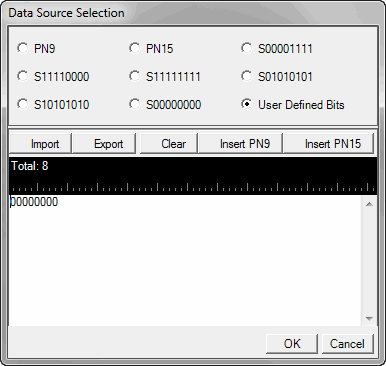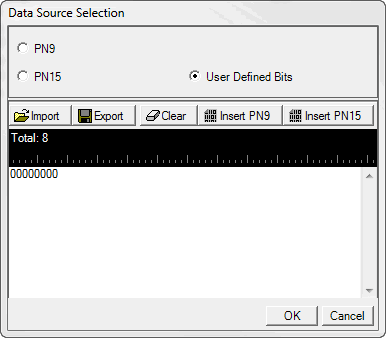

Choice: Single Packet | Multiple Packet
Default: Single Packet
Double-click or use the drop down menu to select the distribution type of packet payload.
When Single Packet is selected, the software creates a waveform that consists of one Bluetooth packet. When downloaded to the signal source, the waveform is repeatedly played back resulting in a packet sequence comprised of identical packets. When Multi Packet is selected, the software creates a waveform that consists of a multiple packet sequence. A data pattern is distributed into the payload portion of each packet in the sequence. Once downloaded to the instrument, the signal generator repeatedly plays back the entire packet sequence. The net result is the ability to configure longer data sequences for analysis.
Choice: PN9 | S11110000 | S10101010 | S11111111 | S00000000 | S00001111| S01010101 | PN15 | User Defined
Default: PN9
Click  to set the data type of the packet payload:
to set the data type of the packet payload:

When continuous (Data Continuous is set to ON) or is selected, the software automatically configures the Length and Repetitions fields. The number of packets required to accommodate the selected continuous PN pattern is also automatically determined and updated the number of bit
When change the payload data type to PN or fixed byte pattern, the payload header byte will update according to the payload content field table below:
|
Payload Content Field |
Payload Description |
|---|---|
|
0000 |
PRBS9 sequence |
|
0001 |
Repeated ’11110000’ sequence |
|
0010 |
Repeated ’10101010’ sequence |
|
0011 |
PRBS15 sequence – reserved for future use |
|
0100 |
Repeated ’11111111’ sequence - reserved for future use |
|
0101 |
Repeated ’00000000’ sequence - reserved for future use |
|
0110 |
Repeated ’00001111’ sequence - reserved for future use |
|
0111 |
Repeated ’01010101’ sequence - reserved for future use |
If is selected as the data pattern, the number of bits, shown in the Data Length field, equals s in the user data file, up to the number of bits allowed for that packet type. Any remaining bits in the user data file beyond the maximum amount will be truncated.
Choice: PN9 | PN15 | User Defined
Default: PN9
Click
 to set the data type of the packet payload:
to set the data type of the packet payload:

When continuous (Data Continuous is set to ON) or is selected, the software automatically configures the Length and Repetitions fields. The number of packets required to accommodate the selected continuous PN pattern is also automatically determined and updated. the number of bit.
If is selected as the data pattern, the number of bits, shown in the Data Length field, equals s in the user data file, up to the number of bits allowed for that packet type. Any remaining bits in the user data file beyond the maximum amount will be truncated.
Choice: On | Off
Default: On
Double-Click or use the drop-down menu to set the continuous state of the packet payload data.
This setting is only available when Payload Distribution is set to Multiple Packet.
Set the repetition number of the packet payload data.
This setting is only available when Payload Distribution is set to Multiple Packet and Data Continuous is set to Off.
Set the number of total bits contained in the payload data.
This setting is only available when Payload Distribution is set to Multiple Packet and Data Continuous is set to Off.
Display the number of full packet occupied by the packet payload.
Display the number of partial packet occupied by the packet payload. Because the payload portion of each packet is filled to capacity if possible, the number of partial packets appended to the end of a packet sequence will always be 0 or 1.
Choice: 0 | 1
Default: 0
Sets the number of padding packets occupied by the packet payload.